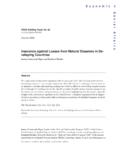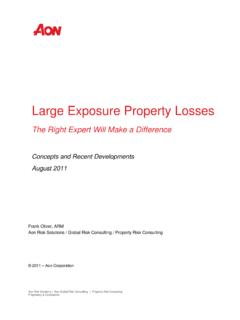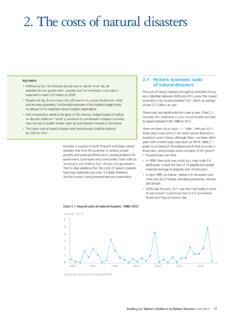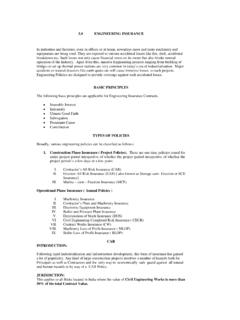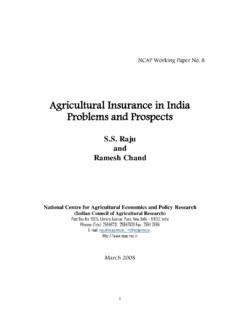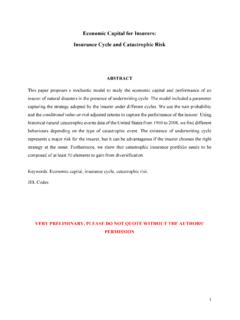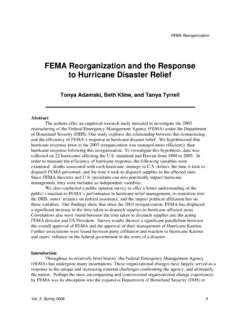Transcription of Reinsurance - actuaries.org.hk
1 1 Reinsurance Introduction Reinsurance is the means by which a direct insurance company seeks protection against the risk of losses; equivalently, reinsurers provide insurance to insurance companies. Due to their ability to specialise and achieve a better economy of scale than direct insurers, reinsurers are able to provide coverage for vairous types of risks ranging from sickness and death to natural disasters such as hurricanes and earthquakes. The policies reinsured is often referred to as the ceding business. There are many reasons for an insurance company to seek Reinsurance for all or part of its liability, which could include but not limited to the followings: Risk transfer The main purpose of Reinsurance is to allow the ceding insurance company to write and assume individual risks that are greater than its capital size would allow, thus offering larger limits of protection to policyholders than otherwise possible.
2 Reinsurance also protects insurers against catastrophic losses. Income smoothing In taking all or part of the risks, Reinsurance helps to smooth out the financial results of an insurance company, making them more predictable by absorbing larger losses. This enables easier business planning and financial projections. Surplus relief Under some typical Reinsurance arrangments, insurance companies are allowed to reduce the amount of net liability they need to hold on its balance sheet by an amount equals to the reserve credit. Very often, reinsurers offer an initial commission or rebate to the insuance companies, thus further helping them to reduce the strain of writing new business.
3 Product development In many circumstances, reinsurers are able to provide expertise about development of the more sophisticated product types. They work closely together with the insurance companies actuarial team to design the best tailor made products. Source of profit Although more of an enhanced benefit instead of a core driver, insurance companies may be motivated by the fact that they are able to reap arbitrage profits by purchasing Reinsurance coverage at a lower rate than what they believe the cost is for the underlying risk. This is achievable because reinsurers are more specialised in certain types of risks, allowing them to attain critical mass and hence a good economy of scale.
4 2 Treaties A Reinsurance treaty represents the terms of agreement between an insurer and a reinsurer. Reinsurance treaties can either be written on a continuous basis or on a term basis. A continuous contract continues indefinitely, but generally has a defined noticing period whereby either party can give its intent to cancel or amend the treaty within a period of about 60 to 90 days. On the contrary, a term agreement has an explicitly built-in expiration date. It is typical for insurers and reinsurers to have long term relationships that span many years. Reinsurance can also be purchased on a per policy basis in which case it is known as facultative Reinsurance , which is commonly used for large or unusual risks that do not fit within standard Reinsurance treaties due to their exclusions.
5 The term of a facultative agreement coincides with the term of the specific policy in concern. Almost all insurers do not place Reinsurance agreements with one single reinsurer but with treaties shared among a number of reinsurers. The reinsurer who sets the terms and contract conditions for the Reinsurance contract is the lead reinsurer, whereas the other companies subscribing to the contract are the following reinsurers. Types of Reinsurance Quota share Quota share, or proportional Reinsurance , involves one or more reinsurers taking on a specified percentage share of each policy from an insurance company. The Reinsurance agreement is typically administered on a periodic basis such as quarterly.
6 At the end of each quarter, the reinsurer(s) will receive that specified percentage of each dollar of premiums from the insurer and will in turn pay that percentage of each dollar of losses as claims recoverable to the insurer. In addition, the reinsurer will normally make an upfront ceding commission payment to the insurer to compensate it for the costs of writing and administering the business. This type of Reinsurance allows insurers to write business which they may not have sufficient capital to retain fully. While premiums and claims are all shared on a pro rata basis, ceding commission from the reinsurer(s) helps the relief of new business strains. Another, though less common, form of proportional Reinsurance is surplus share.
7 An insurance company defines a policy limit amount X and each additional amount of X is considered as a layer. In the simplest form of arrangement, if the insurance company issues a policy with X = US$100,000 coverage, all of the premiums and claims generated from the policy will be retained by the insurer. If a US$200,000 policy is issued then half of the premiums and claims will be ceded to the reinsurer (1 additional layer); whereas for a US$800,000 policy the additional 7 layers of coverage will be ceded to reinsurer(s) implying a quota share percentage of There is usually a maximum number of layers defined in the terms of agreement between the insurer and reinsurer, and this in turn determines the maximum policy limit that can be offered by the insurance company to policyholders.
8 Excess of loss Excess of loss Reinsurance is in essence non-proportional Reinsurance , under which an insurer sets a retention limit of policy coverage, and the reinsurer will take on any losses in excess of that 3 specified retention amount. An example of this form of Reinsurance is where the insurer is prepared to accept a loss of HK$1 million for any loss which may occur and purchases Reinsurance of HK$4 million in excess of the retention limit. If a HK$ million claim occurs the insurer is able to recover the extra million from the reinsurer. In this case, for any claims exceeding HK$5 million, the insurer will not be able to fully recover the claims payable from the reinsurer, hence insurance companies often purchase a few excess layers of Reinsurance .
9 This type of excess of loss Reinsurance is typically known as per risk Reinsurance . Excess of loss Reinsurance can also be on a per occurrence, or catastrophe, level. In catastrophe excess of loss, the insurance policy limits must be less than the Reinsurance retention amount. An example of this form of Reinsurance involves an insurance company writing a homeowner's contract with policy limit up to HK$1,000,000 and then purchase catastrophe Reinsurance of HK$60,000,000 in excess of HK$1,000,000. In such circumstances, the insurance company would recover from reinsurers in the event of multiple losses in one event such as earthquake, flood or typhoon. This is more commonly seen in the general insurance domain.
10 Retrocession Sometimes, Reinsurance companies themselves also resort to purchasing Reinsurance and this is known as a retrocession. The type of Reinsurance is normally offered by some other Reinsurance companies. The Reinsurance company who sells the Reinsurance in this case is known as retrocessionaires whereas the ceding Reinsurance company is known as the retrocedent. Demand for retrocession arises when a reinsurer providing quota share Reinsurance capacity to direct insurers may want to protect its own exposure to catastrophes by purchasing excess of loss protection. Alternatively, a reinsurer offering excess of loss Reinsurance protection may look to protect itself against an accumulation of losses in different branches of business which may all become affected by the same catastrophe.
